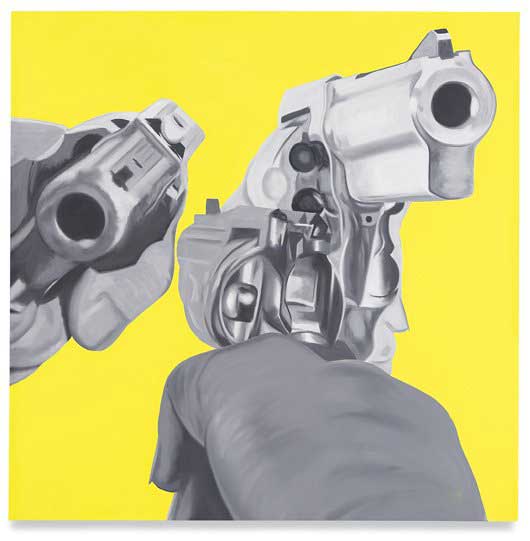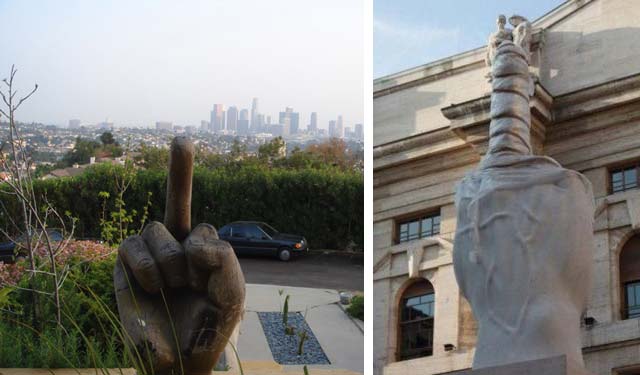pipeline
Every town I go to is like a lock without a key

A new logo for Gap that debuted to much criticism Wednesday might not be the perfect fit, Bill Chandler, vice president of corporate communications of Gap, tells Co.Design. “We love the design, but we’re open to other ideas and we want to move forward with the best logo possible,” he says.
Chandler confirmed last night’s message from Gap’s Facebook account (using the old logo as their avatar), which announced the new logo is actually part of a crowdsourcing project. He would not say when — before or after the tidal wave of criticism — Gap decided to participate in one of the most contentious practices in design, in which regular Joes and Janes compete to create a logo that’s better than the one made by a professional. The logo itself was not a PR stunt, Chandler says.
The new logo was designed by Trey Laird and his firm Laird and Partners, who have served as Gap’s creative directors for many years.
previously:

{ left to right: American Apparel ad 2005, Gap ad 2009, Laird+Partners About us page }
Cheche, get the yayo

{ James Rosenquist, Wild West World, 1996 | Related: Tennessee is one of four states, along with Arizona, Georgia and Virginia, that recently enacted laws explicitly allowing loaded guns in bars. | NY Times | full story }
related { What distinguishes groups like this one from a shooting club or re-enactment society is the prospect of actual bloodshed, which many Ohio Defense Force members see as real. As militias go, the Ohio Defense Force is on the moderate side. Scores of armed antigovernment groups, some of them far more radical, have formed or been revived during the Obama years, according to law-enforcement agencies and outside watchdogs. | The Secret World of Extreme Militias | Time | full story }
And walk through the strip with a nine in the ox

{ Colonel Rosa Klebb, a high ranking member of the feared Russian counter-intelligence agency SMERSH, and main antagonist from the James Bond film and novel From Russia with Love | Wikipedia | more }
Okay, hot shot, okay! I’m pouring!
Laws banning texting or talking on a mobile phone while driving don’t reduce car accidents.
“In fact,” concludes the US Highway Loss Data Institute, “[texting] bans are associated with a slight increase in the frequency of insurance claims filed under collision coverage for damage to vehicles in crashes.”
This counter-intuitive revelation comes from a study by the HLDI, which compared insurance-claim data in states that enacted texting bans with the same data in states where no such laws exist. Data from after the bans took affect was also compared to stats before the bans took effect.
Texting bans did not reduce accident rates, and in some states the accident rates increased after the bans went into effect. “In California, Louisiana and Minnesota,” the HDLI reports, “the bans are associated with small but statistically significant increases in collision claims (7.6%, 6.7%, and 8.9%, respectively).”
Malasio, twenty grand in chips at a dice game
{ It might be a place that only a lichen or pond scum could love, but astronomers said Wednesday that they had found a very distant planet capable of harboring water on its surface, thus potentially making it a home for plant or animal life. Nobody from Earth will be visiting anytime soon: The planet, which goes by the bumpy name of Gliese 581g, is orbiting a star about 20 light-years away in the constellation Libra. | NY Times | full story }
‘For every moment of triumph, for every instance of beauty, many souls must be trampled.’ –Hunter S. Thompson

Red is a color evoked by light consisting of the longest wavelengths of light discernible by the human eye.
Longer wavelengths than this are called infrared (below red), and cannot be seen by the naked human eye.
{ Wikipedia | Continue reading }
In Judo, for instance, fighters are allocated Blue or White prior to competition, and in Taekwon-Do, the colours are Red and Blue. Boxers often wear multi-coloured or patterned trunks, but the colour of the gloves is often different.
Hill and Barton (2005) demonstrated that in the 2004 Olympic Games Red competitors were significantly more successful than blue competitors in an even contest. Basically, Red doesn’t give you a +10 str, but it will a) tip the bias of the point recorders in your favour; b) increase one’s competitiveness; or c) scare you opponent just enough so that you have an advantage.
Their paper, published in Nature, does not speculate on the cause – a, b, and c are my own speculations. They also found that Red vs. non-red and non-blue also tipped the advantage to the red competitors. It kind of stands to reason – red is a scary colour, it’s a natural marker of many evolutionary elements, and it’s visually arresting , like black.
I thought maybe it has to do with dominance of colour – but Dijkstra and Preenen (2008) demonstrated that in Judo (where competition is between blue v white) there is no relative advantage to blue – which is arguable the more dominant colour.
photo { Adam Amengual }
‘For to win one hundred victories in one hundred battles is not the acme of skill. To subdue the enemy without fighting is the acme of skill.’ –Sun Tzu
In thinking about Afghanistan, it is essential that we begin by thinking about the nature of guerrilla warfare against an occupying force. The guerrilla lives in the country. He isn’t going anywhere else, as he has nowhere to go. By contrast, the foreigner has a place to which he can return. This is the core weakness of the occupier and the strength of the guerrilla. The former can leave and in all likelihood, his nation will survive. The guerrilla can’t. And having alternatives undermines the foreigner’s will to fight regardless of the importance of the war to him.
The strategy of the guerrilla is to make the option to withdraw more attractive. In order to do this, his strategic goal is simply to survive and fight on whatever level he can. His patience is built into who he is and what he is fighting for. The occupier’s patience is calculated against the cost of the occupation and its opportunity costs, thus, while troops are committed in this country, what is happening elsewhere?
Tactically, the guerrilla survives by being elusive. He disperses in small groups. He operates in hostile terrain. He denies the enemy intelligence on his location and capabilities. He forms political alliances with civilians who provide him supplies and intelligence on the occupation forces and misleads the occupiers about his own location. The guerrilla uses this intelligence network to decline combat on the enemy’s terms and to strike the enemy when he is least prepared. The guerrilla’s goal is not to seize and hold ground but to survive, evade and strike, imposing casualties on the occupier. Above all, the guerrilla must never form a center of gravity that, if struck, would lead to his defeat. He thus actively avoids anything that could be construed as a decisive contact. (…)
The asymmetry of this warfare favors the guerrilla. This is particularly true when the strategic value of the war to the occupier is ambiguous, where the occupier does not possess sufficient force and patience to systematically overwhelm the guerrillas, and where either political or military constraints prevent operations against sanctuaries.
Witnessing a horse being whipped by a coachman at the Piazza Carlo Alberto, Nietzsche threw his arms around the horse’s neck and collapsed

Horses have become so devalued in Dublin they have been swapped for a mobile phone or purchased for as little as €15, an Oireachtas committee was told yesterday.
The Committee on Agriculture, Fisheries and Food was also told welfare problems in the capital included animals being starved, ridden to exhaustion, beaten, slashed, rammed by cars and set alight.
Dublin City Council deputy city manager Philip Maguire said there were only 30 licensed horses in Dublin, mainly carriage horses, but there were hundreds of unidentified horses in the city.
The Committee will continue to monitor the economic outlook and financial developments

It has always been tough for literary fiction writers to get their work published by the top publishing houses. But the digital revolution that is disrupting the economic model of the book industry is having an outsize impact on the careers of literary writers.
Priced much lower than hardcovers, many e-books generate less income for publishers. And big retailers are buying fewer titles. As a result, the publishers who nurtured generations of America’s top literary-fiction writers are approving fewer book deals and signing fewer new writers. Most of those getting published are receiving smaller advances.
“Advances are down, and there aren’t as many debuts as before,” says Ira Silverberg, a well-known literary agent. “We’re all trying to figure out what the business is as it goes through this digital disruption.”
Much as cheap digital-music downloads have meant that fewer bands can earn a living from record-company deals, fewer literary authors will be able to support themselves as e-books win acceptance, publishers and agents say.
photo { Tim Geoghegan }
previously { Seth Godin: The new dynamics of book publishing }
From the top of it all life itself seems a whole mistake
Ben Bernanke has not only refused to abandon his idee fixe of an “inflation target”, a key cause of the global central banking catastrophe of the last twenty years (because it can and did allow asset booms to run amok, and let credit levels reach dangerous extremes).
Worse still, he seems determined to print trillions of emergency stimulus without commensurate emergency justification to test his Princeton theories, which by the way are as old as the hills. Keynes ridiculed the “tyranny of the general price level” in the early 1930s, and quite rightly so. Bernanke is reviving a doctrine that was already shown to be bunk eighty years ago.
{ Telegraph | Continue reading }
Structural unemployment is a fake problem, which mainly serves as an excuse for not pursuing real solutions.
Who are these wise heads I’m talking about? The most widely quoted figure is Narayana Kocherlakota, the president of the Federal Reserve Bank of Minneapolis, who has attracted a lot of attention by insisting that dealing with high unemployment isn’t a Fed responsibility: “Firms have jobs, but can’t find appropriate workers. The workers want to work, but can’t find appropriate jobs,” he asserts, concluding that “It is hard to see how the Fed can do much to cure this problem.”
Now, the Minneapolis Fed is known for its conservative outlook, and claims that unemployment is mainly structural do tend to come from the right of the political spectrum. But some people on the other side of the aisle say similar things. For example, former President Bill Clinton recently told an interviewer that unemployment remained high because “people don’t have the job skills for the jobs that are open.”
Well, I’d respectfully suggest that Mr. Clinton talk to researchers at the Roosevelt Institute and the Economic Policy Institute, both of which have recently released important reports completely debunking claims of a surge in structural unemployment.
After all, what should we be seeing if statements like those of Mr. Kocherlakota or Mr. Clinton were true? The answer is, there should be significant labor shortages somewhere in America — major industries that are trying to expand but are having trouble hiring, major classes of workers who find their skills in great demand, major parts of the country with low unemployment even as the rest of the nation suffers.
None of these things exist. Job openings have plunged in every major sector, while the number of workers forced into part-time employment in almost all industries has soared. Unemployment has surged in every major occupational category. Only three states, with a combined population not much larger than that of Brooklyn, have unemployment rates below 5 percent.
Oh, and where are these firms that “can’t find appropriate workers”? The National Federation of Independent Business has been surveying small businesses for many years, asking them to name their most important problem; the percentage citing problems with labor quality is now at an all-time low, reflecting the reality that these days even highly skilled workers are desperate for employment.
So all the evidence contradicts the claim that we’re mainly suffering from structural unemployment. Why, then, has this claim become so popular?
Part of the answer is that this is what always happens during periods of high unemployment — in part because pundits and analysts believe that declaring the problem deeply rooted, with no easy answers, makes them sound serious.
The blue for, hoping against hope
1. 65% of 3-year-old children are spanked at least once by their parents during the previous month.
2. The odds of using physical punishment doubled in households where parents used aggression against each other. This is not surprising, since physical punishment is a form of interpersonal aggression.
3. Maternal stress significantly increased the odds of using physical punishment. This is also not surprising since physical punishment is more likely to be used by parents who are angry.
4. Maternal depression significantly increased the odds of using physical punishment.
5. The odds using of physical punishment were not associated with maternal education, but when the father had a college degree, both the father and the mother were significantly less likely to use physical punishment.
A smile that verged on tears, and then they parted
Over the last century, 98pc of the world’s tiger population has been wiped out, first by big game hunters, and latterly by poachers, who kill these magnificent creatures and hack them to pieces.
And for what? Well, money, for one thing. The rarer tigers become, the more valuable they are to the poachers, who sell their bones and organs on the black market for traditional Chinese medicines. (…) which is said to have aphrodisiac qualities. (…)
Scientific studies have shown that the claims made for tiger penises are, if you’ll pardon the expression, bollocks. But so far that’s failed to prevent the carnage escalating.
There are only a few thousand tigers left in the wild. They could well disappear off the face of the planet within 10 years.
Enjoying the evening scene and the air which was fresh but not too chilly

The performer-writer Ann Liv Young belongs to the movement in the arts that was labeled Sensation in the 1990s. She performed “Snow White” naked, apart from a Disney mask on her face, while heavily pregnant. Dildos and masturbation have been part of her theatrical fare. At MoMA P.S. 1 in February she insulted a fellow artist’s work (accompanied by urination and masturbation) until management turned the lights off on her. And on Friday and Saturday she performed a one-woman “Cinderella” at the Issue Project Room in Gowanus, Brooklyn. In this, she converses with members of the audience and also urinates and defecates onstage. (…)
Waiting 10 minutes for someone to defecate onstage is boring.
unrelated { Upcoming free museum days in NYC }
illustration { Mathias Schweizer’s Malamerde }














